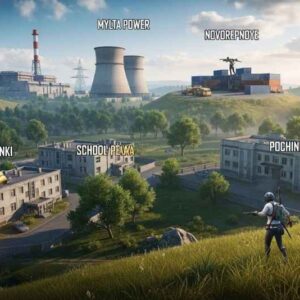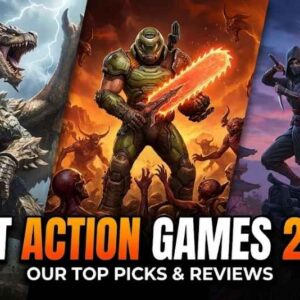In the ever-evolving world of video games, few genres have captured the imagination of millions like the Battle Royale. What began as a scrappy experiment in modding communities has ballooned into a multi-billion-dollar juggernaut, blending high-stakes survival, social spectacle, and endless replayability. By 2025, Battle Royale titles aren’t just games—they’re cultural touchstones, esports empires, and even social hubs where friends forge bonds amid chaos. If you’re a gamer dipping your toes into this frenzy or a veteran wondering how it all snowballed, this deep dive unpacks the journey. We’ll explore its gritty origins, explosive growth, and what lies ahead, arming you with insights to level up your playstyle and appreciation.
Whether you’re optimizing your setup for peak performance or debating the genre’s staying power, understanding Battle Royale‘s rise equips you to navigate its competitive landscape. Let’s drop in.
The Humble Beginnings: Mods That Sparked a Revolution
The Battle Royale genre didn’t emerge from a glossy studio boardroom; it was born in the DIY spirit of PC modders. Picture this: early 2010s, players tinkering with military sims, craving something rawer than scripted campaigns. The seed was planted in 2013 with ARMA 2, a hardcore tactical shooter known for its unforgiving realism.
ARMA 2’s Last Survivor: The Mod That Started It All
Enter Brendan Greene, a modder under the handle “PlayerUnknown.” Inspired by the 2000 Japanese film Battle Royale—a dystopian tale of teens forced into a deathmatch on an island—Greene crafted a mod called DayZ: Battle Royale. In ARMA 2, players spawned on a massive map with nothing but their wits, scavenging for gear while a toxic gas closed in, forcing confrontations. Up to 100 players per match, one victor. No checkpoints, no mercy.
This wasn’t polished entertainment; it was a brutal proof-of-concept. Matches could drag for hours, plagued by glitches and empty lobbies. Yet, it hooked players with its tension: every bush rustled with paranoia, every loot crate a gamble. Greene’s mod addressed common gripes in multiplayer shooters—predictability and lack of stakes—by making every life count. Actionable tip: If you’re new, start with ARMA‘s free weekends on Steam to feel that primal mod energy. Tweak server settings for smaller squads to build survival instincts without the full 100-player overwhelm.
By 2014, Greene iterated on his idea in ARMA 3, refining the circle mechanic and loot distribution. Word spread via forums like Reddit’s r/battleroyale, where players dissected strategies: “Hot drop or edge camp?” These discussions birthed community norms, like the “third-partying” tactic—ambushing fights from afar. The mod’s success proved a thesis: survival + scarcity = addiction.
PUBG: From Indie Darling to Standalone Sensation
Greene’s mod caught the eye of South Korea’s Bluehole Studio (now Krafton). In 2016, they greenlit PlayerUnknown’s Battlegrounds (PUBG) as a full game. Launched in early access on Steam in March 2017, PUBG ditched ARMA‘s clunky engine for Unreal Engine 4, smoothing visuals without sacrificing grit.
Launch Chaos and Viral Magic
PUBG’s debut was meteoric. Within months, it sold 5 million copies, peaking at 3 million concurrent players—a Steam record. Why? Authentic tension. Dropping from a plane onto maps like Erangel (a foggy, war-torn island), you’d hear distant gunfire, hearts pounding. The game’s “chicken dinner” victory emote became slang for triumph.
But it wasn’t flawless. Desync issues and hackers plagued servers, sparking debates on fair play. Krafton responded with anti-cheat tools and console ports in 2018, expanding to Xbox and PS4. For players frustrated by bugs, here’s actionable advice: Use tools like PUBG’s replay system to analyze deaths—spot patterns in your positioning. Pair it with voice comms software like Discord for squad synergy, turning losses into learning loops.
By 2018, PUBG’s revenue topped $1 billion, fueling esports like the PUBG Global Invitational. It normalized Battle Royale mechanics: shrinking zones, randomized loot, and cross-platform play. Yet, its PC-first ethos kept it niche among casuals—until a rival crashed the party.
Fortnite: The Free-to-Play Tsunami That Redefined Accessibility
If PUBG was the gritty pioneer, Epic Games’ Fortnite: Battle Royale was the pop star. Launched in September 2017 as a free mode within the paid Fortnite: Save the World, it exploded in 2018, peaking at 78.3 million players in a single month.
Building Mechanics and Crossover Appeal
Fortnite’s secret sauce? Building. While PUBG emphasized realism, Fortnite let players construct ramps and forts mid-fight, turning gunplay into a creative ballet. Vibrant graphics, cartoonish aesthetics, and emotes like the floss dance made it family-friendly—parents joined kids without flinching at gore.
Epic’s business model was genius: free entry, monetized via battle passes and cosmetics. A $9.99 seasonal pass unlocked skins and challenges, earning billions without pay-to-win. This democratized Battle Royale, answering the common question: “How do I get into this without spending?” Simple—download, squad up, and grind challenges for free rewards.
Cultural crossovers amplified it: Travis Scott’s virtual concert in 2020 drew 27 million viewers, blending gaming with music. For creators, Fortnite’s Unreal Engine tools enabled custom islands via Creative mode. Aspiring mapmakers, take note: Study Epic’s guidelines for V-Bucks earnings—design obstacle courses or horror escapes to monetize your ideas.
By 2025, Fortnite’s Chapter 6 introduces weather-altering events, keeping the formula fresh. It’s a masterclass in iteration: Listen to feedback, drop limited-time modes (LTMs) like No Build for accessibility.
The Explosion: A Genre Multiplies into Mayhem
PUBG and Fortnite cracked the code, unleashing a flood. By 2025, Battle Royale boasts over 20 major titles, each tweaking the formula.
Apex Legends: Heroes Meet High-Octane Action
Respawn’s Apex Legends (2019) fused Battle Royale with hero shooters. Pre-made legends like Wraith (teleporting scout) or Gibraltar (tank) added roles, making squads feel like teams. Free-to-play with smart loot (no digging for meds), it hit 50 million players in a month. Pro tip: Master “pings”—a non-verbal comms system that shares enemy spots without voice chat, ideal for solo queue.
Call of Duty: Warzone and Mainstream Muscle
Activision’s Warzone (2020) brought AAA polish: massive Verdansk map, gulag 1v1 respawns. Integrated with Modern Warfare, it peaked at 100 million downloads. Its loadout drops mechanic—calling in custom guns—solves the “gear envy” gripe. In 2025’s Urzikstan reboot, focus on contracts (side quests for cash) to fund faster buys.
Other standouts: Valorant‘s RiotX Runway mode experiments with ability-based royales, while Fall Guys (2020) softens it into party chaos. Mobile hits like Free Fire dominate in Asia, with 1 billion downloads by optimizing for low-end devices—key for emerging markets.
This proliferation answers “What’s the best Battle Royale for me?” Beginners: Fortnite for fun. Hardcore: PUBG for realism. Team players: Apex.
Cultural and Economic Tsunami: Beyond the Screen
Battle Royale‘s rise reshaped gaming. Economically, the genre generated $20 billion by 2024, per Newzoo, with esports viewership rivaling traditional sports. PUBG Mobile’s PMWL 2023 drew 100 million online viewers.
Socially, it’s a connector: 70% of players squad with friends, per ESA surveys, combating isolation. But challenges persist—toxic lobbies and loot box debates. Developers counter with reporting tools and wellness features, like Apex’s “Take a Break” reminders.
For streamers, it’s gold: Twitch categories for Battle Royale average 1.5 million viewers daily in 2025. Aspiring pros? Build a highlight reel on YouTube, focusing on clutch plays, and enter qualifiers via game-specific paths.
Peering into 2025 and Beyond: Evolution or Exhaustion?
As VR and metaverses loom, Battle Royale adapts. Roblox’s royale experiments hint at user-generated worlds, while The Finals (2023) adds destructible environments. Sustainability questions arise: Will battle passes fatigue players? Trends point to hybrid modes—royale + RPG elements in Exoborne.
Optimism prevails: The genre’s core—shared adrenaline—endures. For longevity, diversify: Alternate with single-player for burnout prevention.
In 2025, Battle Royale isn’t a fad; it’s foundational, much like FPS in the ’90s. Its epic rise from PUBG mods teaches resilience: Innovate, listen, iterate.
(Word count: 1,512)
FAQ
What was the first Battle Royale game?
The genre traces to Brendan Greene’s 2013 ARMA 2 mod, but PUBG (2017) was the first standalone title.
How do I improve in Battle Royale games as a beginner?
Focus on sound cues (use headphones), land in low-traffic zones for safe looting, and practice in training modes. Squad with communicative friends for faster growth.
Is Battle Royale free to play?
Most are, like Fortnite, Apex, and Warzone. PUBG offers a free tier now, but premium features vary.
Why did Fortnite surpass PUBG in popularity?
Fortnite’s free model, building mechanics, and pop culture tie-ins made it more accessible and shareable, especially for younger audiences.
What’s next for the Battle Royale genre in 2025?
Expect more crossovers (e.g., Marvel integrations), VR adaptations, and eco-friendly servers to reduce carbon footprints.






